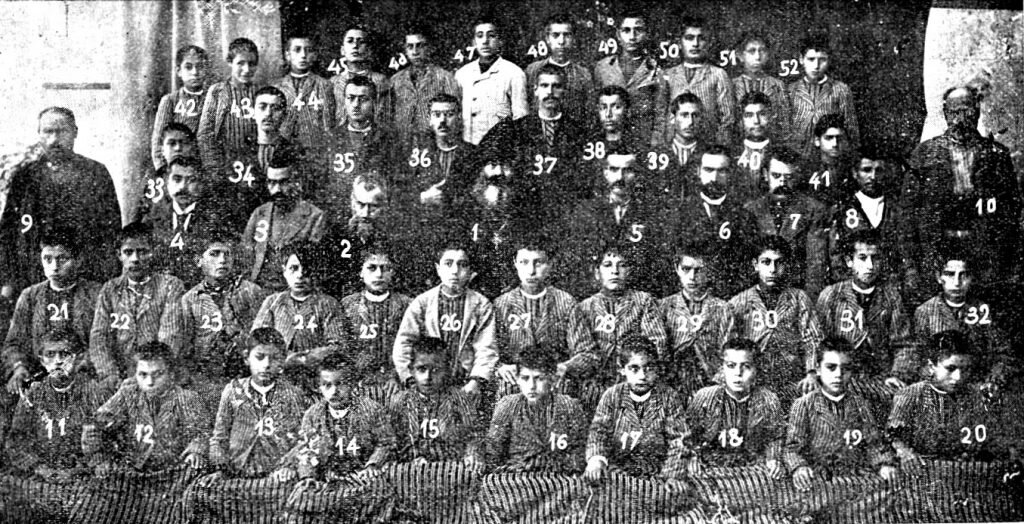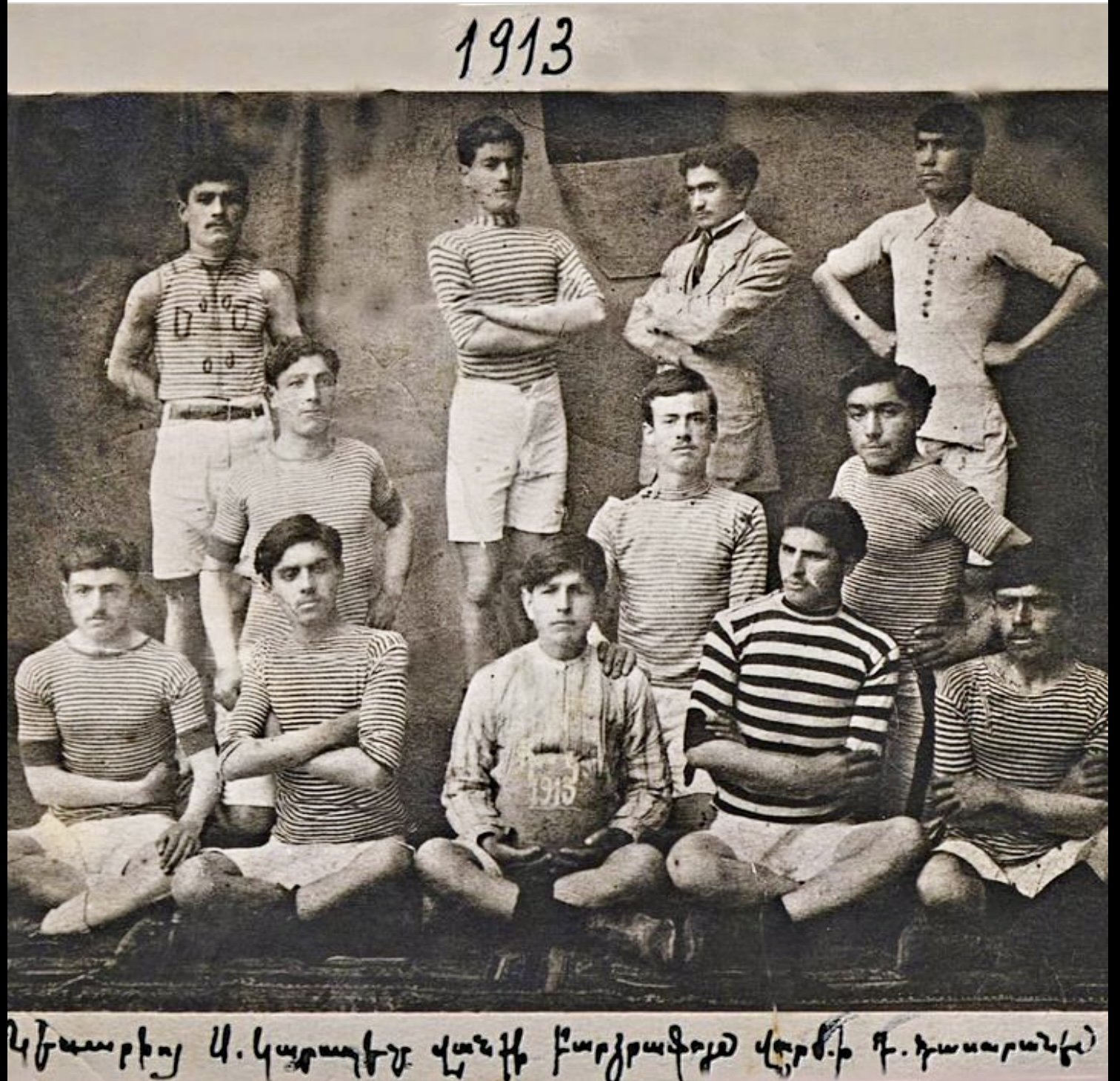The Haygian School
The first school in Efkere, with the exception of the religious schooling at Surp Garabed Monastery, was established in the 1820’s under the directions of Bavghant Rousinian. Its first teacher was Deacon Asdvadzadour, a student at the monastery who went on to later become a priest in the village.
In the 1870’s, it was referred to as the Haygian School. In the 1872-1873 season, it had 120 male students.
Football team at Surp Garabed Monastery, 1913. Photo courtesy Artür Çubukçu, whose maternal grandfather, Agopcan Zergeroglu is in the middle row.
A new school building was later constructed next to Surp Stepanos Church, and the school was referred to as the Torkomian-Akabian School. In 1901, there were 170 students (130 boys, 40 girls).
There is evidence, however, that by the end of the 19th century, disagreements between political parties in Efkere as to how the school should be run had a negative impact on the school. The school split into two separate schools, run by separate political parties, and reports suggest that the schools suffered.
A girls school was present in Efkere since at least 1886 and, in 1913, the Educational Society for the Girls School of Hefkara was formed in New York, with the goal of raising money for the school. There is also significant surviving correspondence between the educational committee in Efkere and Efkeretzis in Detroit between 1912 and 1913 thanking them for the contributions made to the school. The contributions made by diasporan Efkeretzis in New York and in Detroit was probably crucial to the completion of not only of the newly re-constructed girls school, but also the newly reconstructed boys school.
There is also significant surviving correspondence between the educational committee in Efkere and Efkeretzis in Detroit between 1912 and 1913 thanking them for the contributions made to the school. The contributions made by diasporan Efkeretzis in New York and in Detroit was probably crucial to the completion of not only of the newly re-constructed girls school, but also the newly reconstructed boys school.
Also, despite the political disagreements that seem to have had their impact on Education in Efkere, a new school was built in the village in 1913 and 1914, likely remaining adjacent to Surp Stepanos church.
In addition, at least a small number of boys from this village went to the city of Talas, southeast of Kayseri, to receive their education at the American School for Boys.
Girls School of Hefkara
The following booklet, printed in New York in 1913, discusses the formation of the “Educational Society of the Girls School of Hefkara (Cesaria).
This was a fundraising compatriotic organization that sought to support the Girls school in Efkere, beginning in 1913. Following the First World War, the Efkere Compatriotic Organization in the United States held on to this name, or used a name such as “The Efkere Educational Union.” It is a fascinating glimpse into the mindset of the Efkeretzis at the time, and the importance they placed on education. Almost certainly the only surviving copy of this booklet. This booklet from the Garabed Kojaian papers.
TRANSLATION OF THE ABOVE DOCUMENT
Statute
Educational Society of the Girls School of Hefkara (Cesaria)
Founded 1913, New York
Gochnag Publishing House
New York, 1913
Preface: We consider reading long discourses or encomia about the helpfulness of the School needless because we see everyday that strong nations measure their greatness by the advancement of their schools and their sciences. Because it is the School that is the source of all their strength, be it economic, moral, or physical.
Humanity is not in its former living conditions. Those conditions have been totally revolutionized. New means in the fields of health, agriculture, art and engineering have been created which are convenient and lucrative. And all those nations that were once large and populous but are today are devoid or far from the knowledge of this progress have gotten run down, are forced to weaken, and one day expire. And human emotionality or previously outlined rights cannot even react on the expiry of a race. The main stimulus for preservation is strength–Strength defines rights, and that Strength is obtained from Knowledge–from the School.
My fellow Armenians, if we still have some sense of self-consciousness, if we still want to stay alive, we need to make a lot more sacrifices than the larger nations. Considering our weakness, we have immense need for Knowledge. Every Armenian two-house village must have its own school. That is the source of our existence, our self-preservation, and will be the weapon of our future Greatness.
In the multi-racial country of the Ottoman Constitution, we will make the strength and advancement of our race felt through the advancement and usefulness of our Schools. We will put the rights we have received and are going to receive on the scale of the balance of our schools’ advancement. But, in this way, we will be able to obtain that advancement only by accordingly fulfilling our duties, which are: living less egocentrically, less covetously. Simply put: all for one and one for all.
We, the founders and members of the Educational Society of the Girls’ School of Hefkara (Cesaria), zealous about the greatness of our Nation and our Village, have deeply scrutinized the helpfulness of the School and, starting in 1913, as one heart and one soul, have further advanced this nation-building establishment and we will not flinch in the face of any difficulties.
And we appeal to the honest community reading these lines, and especially to our Compatriots of Cesaria, to come to bear the invincible shield of our nations greatness and self-defense, which are the School and Knowledge.
Therefore, long live the Girls School of Hefkara.
May Armenian education live long and always.
Students of Surp Garabed Monastery
Fortunately, not only class photographs, but also individual photo cards exist for numerous students at the Monastery. Examples are shown below.
Agopcan Zergeroglu, 1910.
In Armenian, on the reverse of the card:
1910
S. G Vank (Surp Garabed Monastery)
Gesaria (Kayseri)
Photo courtesy Artür Çubukçu
Two photographs of Krikor Garabed Koltukian.
Photos courtesy Bruce Wallace
Unknown student at Surp Garabed Monastery.










